Gateshead and District Tramways
History
Powers to build approximately 8 miles of 3ft 6ins-gauge tramway in and around Gateshead were obtained on the 12th August 1880,= under the c. The company was authorised to use animal, steam or mechanical power, but subject to Board of Trade consent, which would be granted for periods of seven years. The act also incorporated a company — the Gateshead and District Tramways Company — to raise the necessary capital, and to construct and operate the tramway.
Having obtained the powers, however, the company now delayed construction. This was probably because it intended to seek further powers to extend the proposed system into the Jarrow (to the east), and ultimately beyond to South Shields, but these plans was frustrated by opposition from two other tramway schemes, which were not only centred on those two towns, but were built to standard gauge. As a result, on the 24th July 1882, the company obtained amended powers — under the Gateshead and District Tramways Act, 1882 — to change the gauge to standard gauge, to abandoned its planned line in Felling and Jarrow, and to extend the time allowed for construction to the 12th August 1883.
The company now pressed on with construction, but was forced once again to go to parliament to increase the time allowed for construction, and to raise more capital; these powers were granted on the 2nd August 1883 under the Gateshead and District Tramways Act, 1883.
The first services commenced on the 22nd October 1883, with the remainder of the system following in stages through to August 1884. The G&DTCo's standard-gauge, steam-operated system extended to 6.22 miles, comprising three lines running from the vicinity of Wellington Street and Hill Street in Gateshead: east-southeastwards to Heworth (along Sunderland Road); southwards to Low Fell (via Durham Road); and southwestwards to Teams (via Askew Road). The initial fleet comprised 14 Black Hawthorn steam engines and 14 Falcon-built trailers; these were supplemented by two more engines and two more trailers in the late 1880s.
The steam tramway appears to have led a relatively uneventful existence, save for the usual complaints from local councils about paving, noise and steam. It certainly carried a respectable number of passengers, but returns for the shareholders were meagre indeed, as was the case on many steam tramways where the City of London Contract Corporation had been involved in the promotion and construction. This company, and its tramway appointees (invariably acolytes of Henry Osbourne O'Hagan, a notorious Victorian businessman who controlled the CofLCC), used various devices, amongst the less underhanded being to ensure that construction contracts were placed with the CofLCC, the tramway companies paying well over the odds in the process. The fact that the G&DTCo paid between 50 to 100% more per mile to construct the tramway than similar concerns elsewhere, speaks for itself.
By the mid-1890s, the company was considering conversion to electric traction, a move which would necessitate Gateshead Corporation deferring its right, under the Tramways Act of 1870, to purchase the tramway at set timepoints, usually 21 years after the authorising act. Meanwhile, the British Electric Traction Company (BETCo) had appeared on the scene, a company that was embarking on a journey that would see it become a major player in the tramway world. It began by purchasing horse and steam-operated tramways across the British Isles with the intention of converting them to electric traction, as well as promoting schemes for completely new electric tramways, and was destined to own, part-own or lease around 50 tramway concerns across the British Isles. On 12th November 1897, the BETCo and the G&DTCo reached a provisional agreement for the former to purchase the latter, providing that it was successful in securing powers to convert and extend the tramway (by circa 6.25 miles), as well in obtaining the agreement of Gateshead Corporation to a 21-year deferment of its right to buy.
The G&DTCo obtained the necessary powers on the 9th August 1899 — under the Gateshead and District Tramways Act, 1899 — as well as the deferment (Gateshead Corporation's right to purchase was extended to the 12th August 1922), so the take-over by the BETCo presumably happened very shortly thereafter.
Construction of the new electric system commenced on the 12th June 1900, with additional powers for further extensions being obtained on the 22nd August 1900 under the Gateshead and District Light Railway Order, 1900. The electric tramway, which retained the standard gauge of the steam tramway, was formally opened on the 8th May 1901, though public services throughout the day remained steam-hauled; the last steam services therefore ran on the evening of the 8th May 1901, with electric services (for the general public) commencing the following day. As had happened with the steam-operated system, the company was forced to go back to parliament for seek authorisation for additional capital, and to abandon a small portion of the planned system; these powers were granted on the 2nd July 1901 under the Gateshead and District Tramways Act, 1901.
The system was initially operated by around 50 tramcars, these being supplemented with further cars as extensions was completed. Powers for extensions to Wrekenton and Bensham were obtained on the 16th August 1909 under the Gateshead and District Tramways Act, 1909.
In 1914, the G&DTCo was placed under the control of the Northern General Transport Company, which had been set up by BETCo to consolidate its transport interests in the area; these also included the Jarrow and District Electric Traction Company, and the Tynemouth and District Electric Traction Company.
As with many tramways, the Great War brought many challenges to the system, with severe shortages of men, extremely heavy loadings (due to war work), and an inability to resource maintenance, either from a manpower or materials perspective, and restrictions on purchasing track and tramcars.
The tramway was extremely well-run and very profitable, with a blanket one-penny fare in force on all bar one route into the 1920s, a policy which ensured consistently high passenger numbers. An indication of just how profitable the concern was can be gleaned from the 1921 dividend of 10%, an almost unheard of figure for a company-owned system, and this at a time when many systems were figuratively on their knees. The company was helped in its endeavours by the good relationship it had with Gateshead Corporation, a situation that undoubtedly contributed to the municipal authority agreeing not to exercise its right to purchase the undertaking in 1922, enabling the company to invest heavily in modernising the system (track and trams).
At its maximum, the G&DTCo owned and operated 12.87 miles of standard-gauge tramway, comprising lines from the river: east-southeastwards to Heworth; southwards to Wrekenton and Low Fell; southwestwards along Windmill Hills, with a branch leading southwards to Saltwell Park and another, also running southwards, to Bensham; and southwestwards along Askew Road to Teams, with a branch leading off westwards to Dunston. The G&DT system was connected to Newcastle Corporation Tramways on the 12th January 1923 when the latter laid tracks across the railway-owned High Level Bridge, after which through services were operated by both the NCT and the G&DTCo. This was followed on the 10th October 1928 by another connection over the newly opened Tyne Bridge.
The tramway continued to carry large numbers of people throughout the 1920s and well into the 1930s, despite the severe economic depression. By the mid 1930s however, the transport landscape was changing, with the NCT instituting its first trolleybus service, which was a tramway replacement rather than a supplementary feeder service. Gateshead Corporation once again waived their right to purchase (in 1936), agreeing to support the company in converting the system to trolleybus operation, powers for which were obtained on the 29th July 1938 (under the Gateshead and District Tramways and Trolley Vehicles Act, 1938). The Second World War, however, stalled all conversion plans, and even after its conclusion the G&DTCo seems to have been happy to spend significant sums on relaying life-expired tramway track, whilst doing little to implement the trolleybus scheme. In the end, the company had a change of heart, convincing the local authorities — Gateshead Corporation and Felling Urban District Council — to support a switch to buses, powers to this end being obtained on the 12th July 1950 under the Gateshead and District Tramways Act, 1950. The act also authorised a change of name to the Gateshead and District Omnibus Company.
The G&DOCo had meanwhile obtained approval to introduce a limited number of bus services, the first of these commencing on the 5th March 1950. The first tramway line to close was to Wrekenton, sometime between June and September 1950 (the precise date the last tram ran has not been recorded), with the last tram of all running on the 4th August 1951; this was not only the last G&DT tram service, but also the last company-operated tram service in the whole of England.
Uniforms
In the 1880s, steam-tram crews wore informal but robust attire, comprising jackets, trousers and bowler hats; no badges of any kind appear to have been worn. The clothing worn by drivers gradually changed, such that by the 1890s, they were wearing very similar attire to their railway counterparts, namely, heavy cotton trousers and jackets, often light in colour, along with soft-topped caps or flat caps. At some point however, and unlike most of their counterparts on other steam tramways, they were issued with a prominent cap badge — probably oval — details of which remain unknown. By this time, conductors were also wearing a uniform of sorts: plain single-breasted jackets with lapels (possibly self-purchased), along with a shirt, tie and soft-topped kepi-style cap; the latter carried a large cap badge (almost certainly the same pattern as that issued to the drivers). A few photographs have survived which show staff in uniforms, but without the cap badge, suggesting that the badges may have been dispensed with at some point, possibly following the British Electric Traction Company (BETCo) take-over of 1899.
Following the introduction of electric services in 1901, G&DTCo staff were issued with the familiar and largely regulation BETCo uniform. Although jackets appeared to vary somewhat between BETCo systems, as well as across the decades, the cap badges, collar designations and buttons invariably followed a standard pattern. The earliest jackets issued to G&DTCo staff were double-breasted with five pairs of buttons (of the standard BETCo pattern, and presumably brass — see link) and lapels; the collars carried individual embroidered initials (possibly ’G D T’ in block capitals), on both the left-hand side and the right-hand side. The tensioned-crown peaked caps carried the standard brass BETCo ‘Magnet & Wheel’ cap badge (see below), worn above an employee number. These jackets were, however, relatively quickly superseded by double-breasted lancer-style tunics with five pairs of buttons (narrowing from top to bottom), stand-up collars and epaulettes (with button fastenings). The collars carried individual metal letters — ‘G & D T Co’ — on the bearer's right-hand side and an employee number on the left-hand side, all presumably brass to match the buttons.
At some point, probably in the late 1920s or early 1930s, the men's tunics were changed to a more modern double-breasted style with five pairs of buttons, waist pockets and lapels. The collars appear to have carried an employee number (in individual metal numerals) on the left-hand side and company initials (‘G & D T Co’) on the right-hand side (in individual metal letters), though sometimes it was just 'G D T'. The practice of wearing employee numbers beneath the ‘Magnet & Wheel’ cap badge appears to have been discontinued by this time. This style of uniform remained unaltered until closure in 1951.
Tramcar crews were also issued with long, double-breasted greatcoats. Up until the 1930s/40s, these had high, fold-over collars and epaulettes, but later on had a more modern cut with lapels, and without epaulettes; these garments seem to have been worn without badges of any kind.
In the early years, inspectors wore single-breasted jackets edged in material of a finer quality than the main jacket, with hidden buttons (or more likely a hook and eye affair), two waist pockets, two breast pockets and stand-up collars, the latter carrying the designation 'Inspector' in embroidered script lettering. Caps were similar to those worn by tramcar crews, but bore an embroidered script-lettering 'Inspector' badge, which in the early years at least, was worn along with the standard BETCo 'Magnet & Wheel' cap badge. In the last decades of the tramway's existence, a more modern gabardine style coat appears to have been worn, though photographic evidence is scanty.
Female staff were employed in considerable numbers in both the Great War and the Second World War to replace men lost to the armed services. During the Great War, conductresses initially wore informal attire, but were subsequently issued with long single-breasted, tailored jackets with five buttons, hip pockets, lapels, and a belt with two buttons; no insignia of any kind appears to have been worn. The ladies were also issued with long double-breasted topcoats with lapels, again seemingly devoid of badges. Headgear consisted of a baggy cap with a stiff glossy peak, sometimes referred to as a 'motor cap', to which the standard BETCo 'Magnet & Wheel' cap badge was affixed, though this was frequently replaced by a regimental sweetheart badge, a common practice at this time. During the Second World War, female conductors were issued with smart single-breasted jackets with four buttons, two breast pockets (with button fastenings), lapels and epaulettes (again with button fastenings). The jackets do not appear to have borne insignia of any kind. The caps were an unusual design reminiscent of military forage caps, sometimes referred to as 'field caps'; they carried the standard ‘Magnet & Wheel’ cap badge.
Further reading
For a history of the Gateshead and District Tramways Company, see: 'The Tramways of Gateshead' by George S Hearse; published by the author (1965).
Images
Steam tram drivers and conductors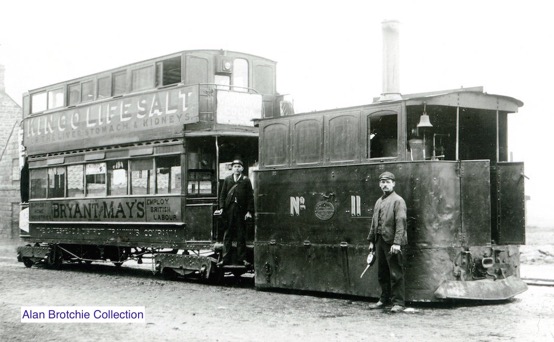
Steam Tram No 11 and trailer in the Sunderland Road depot yard — photo undated, but probably taken in the early 1890s.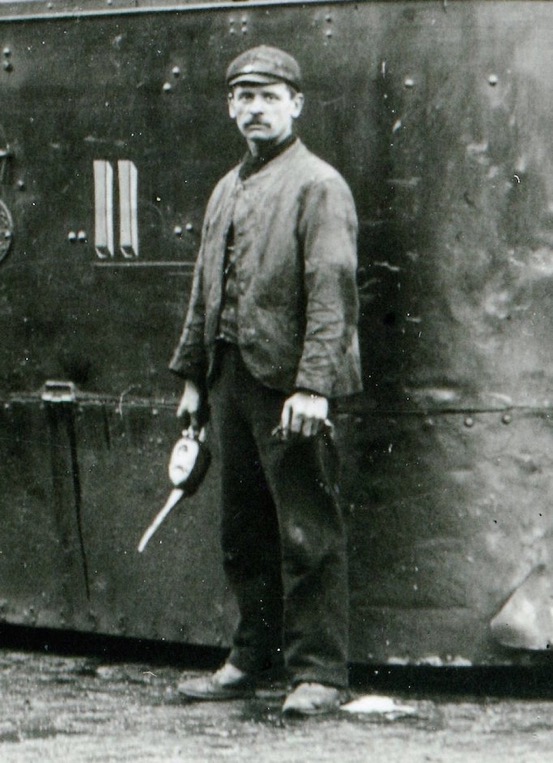
An enlargement of the above photograph showing the driver, oil can in hand; he is wearing typical footplate attire along with a tight-fitting and oily cloth cap.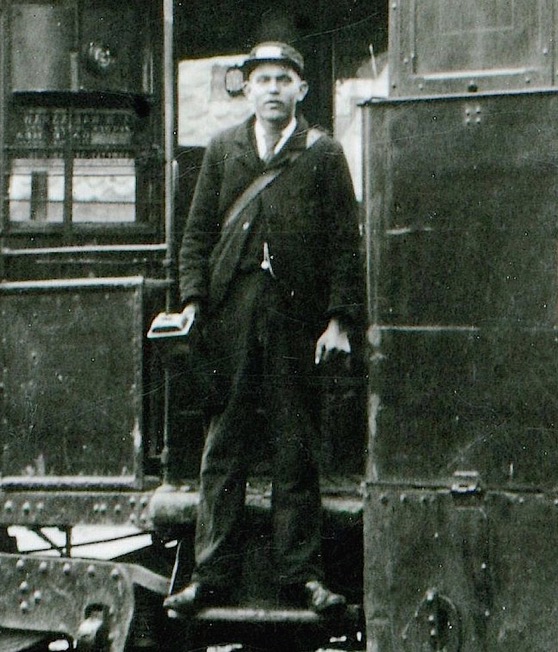
Another blow-up of the above photograph, showing the conductor. He is wearing a plain, single-breasted jacket (possibly self-purchased) and a company-issued kepi-style cap; the latter bears a large metallic cap badge, an example of which has yet to come to light. He is carrying a Kayes 'Patent' Fare Box in his right hand.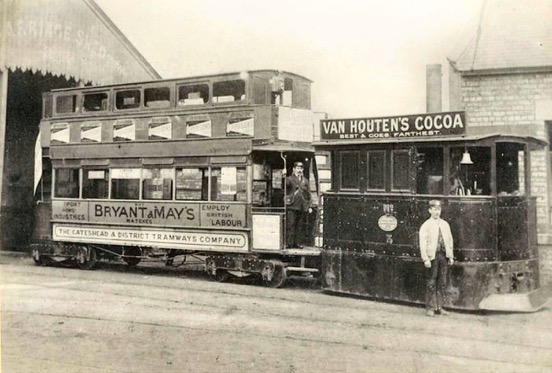
Steam Tram No 3 at the depot in Sunderland Road — photo undated, but probably taken in the mid 1890s. With thanks to Malcolm Fraser.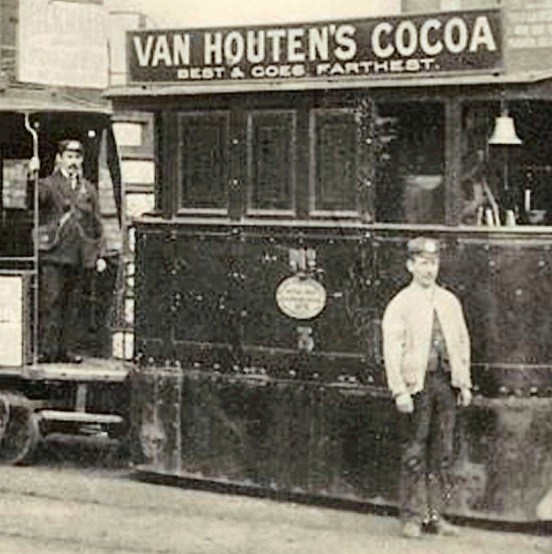
An enlargement of the above photograph showing the driver and the conductor, both of whom are wearing prominent cap badges. The conductor is again wearing a kepi-style cap and a single-breasted jacket.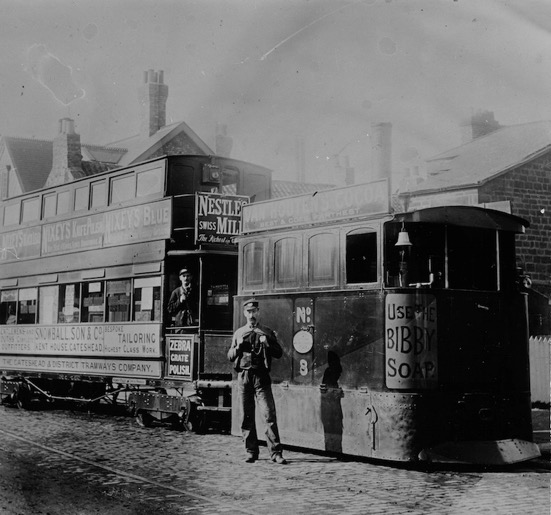
A well-known shot of Steam Tram No 8, a Black Hawthorn product, in the depot yard with what is believed to be a Falcon-built trailer — photo undated, but probably taken in the mid-to-late 1890s. Photo courtesy of the National Tramway Museum. 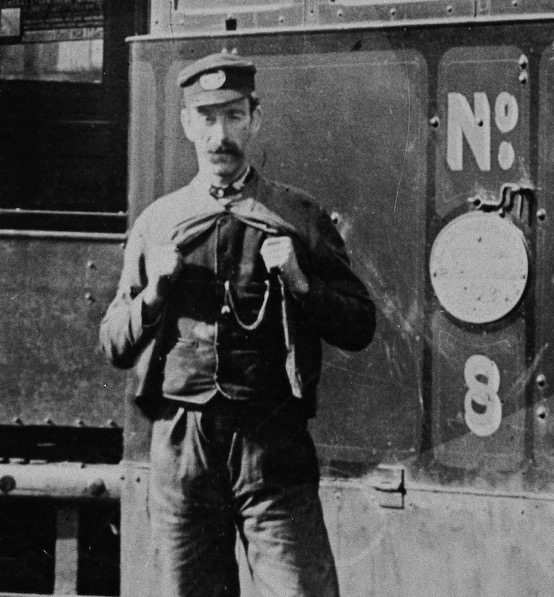
An enlargement of the above photograph showing the driver, in soft-topped cap bearing a large oval cap badge.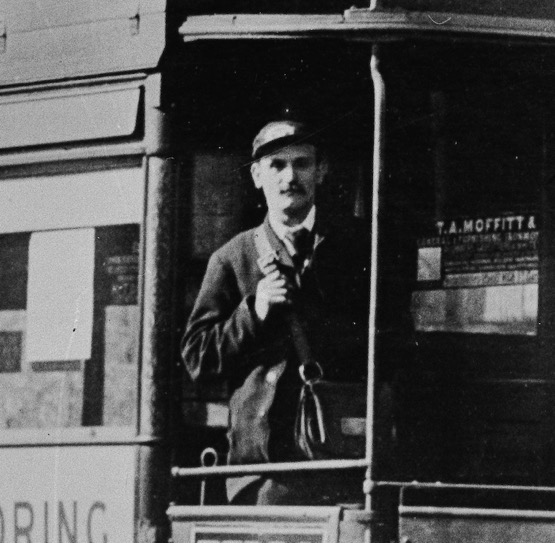
Another blow-up of the previous photograph, this time showing the conductor. He appears to be wearing a uniform jacket along with a kepi-style cap bearing the usual large oval cap badge.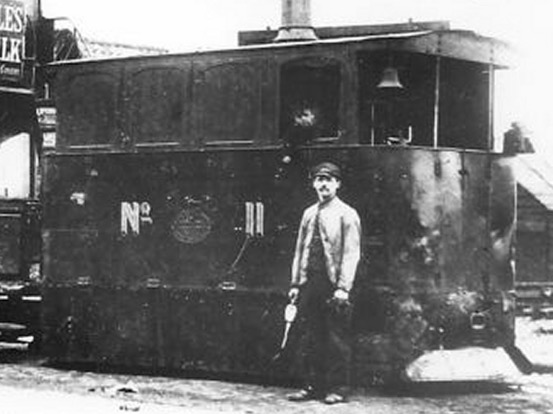
The driver of Steam Tram No 11, oil can in hand, poses for the cameraman, wearing typical railway footplate-like attire — photo undated, but probably taken in the late 1890s. The driver does not appear to be wearing a cap badge, suggesting that this photo may post-date the BETCo take-over of 1899. With thanks to Malcolm Fraser.
Motormen and conductors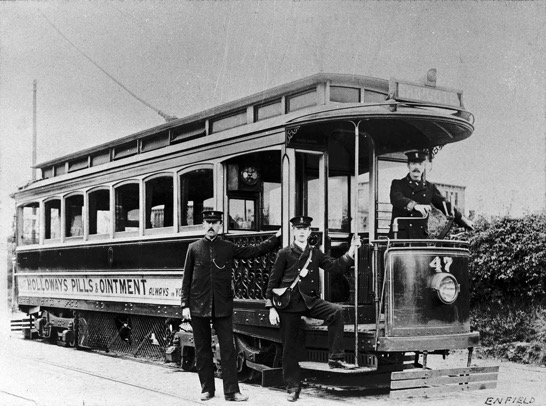
Inspector C Day, Conductor W Dargard and Motorman H Malton pose with Tramcar No 47 in 1902. Image kindly supplied by Beamish Museum Limited (see link), image copyright Beamish Museum Limited.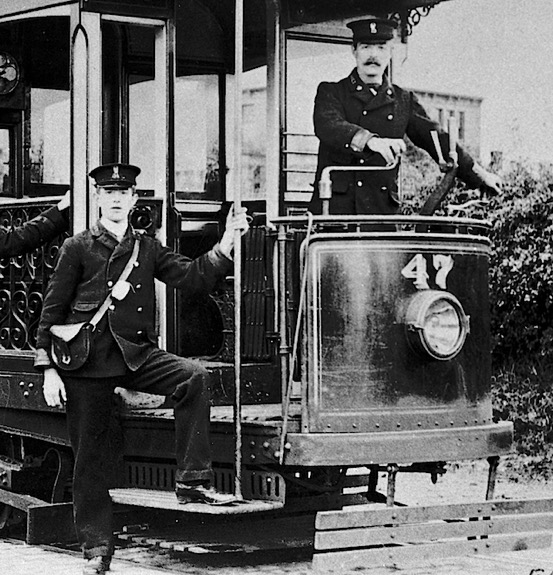
An enlargement of the above photograph showing the conductor and the motorman. Both men are wearing double-breasted jackets with lapels, the collars of which appear to carry embroidered 'G D T' system initials. Their caps bear the standard BETCo 'Magnet & Wheel' cap badge, along with an employee number.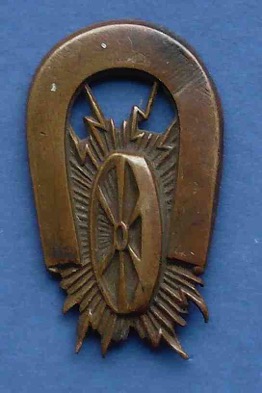
Standard British Electric Traction Company ‘Magnet & Wheel’ cap badge, as issued to staff working the G&DTCo electric services, i.e., from 1901 onwards — brass. Author's Collection.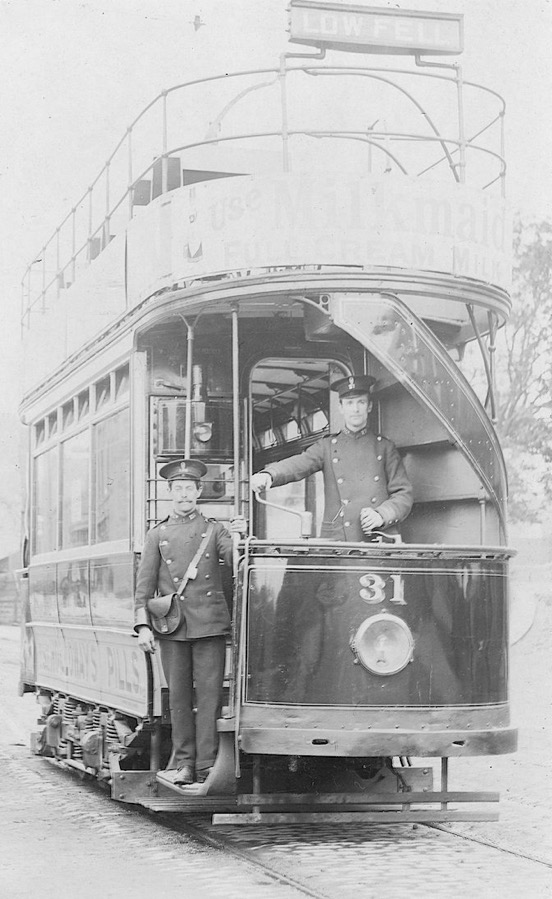
The crew of Tramcar No 31 pose for the camera somewhere on the Low Fell route — photo undated, but certainly taken prior to the Great War. Author's Collection.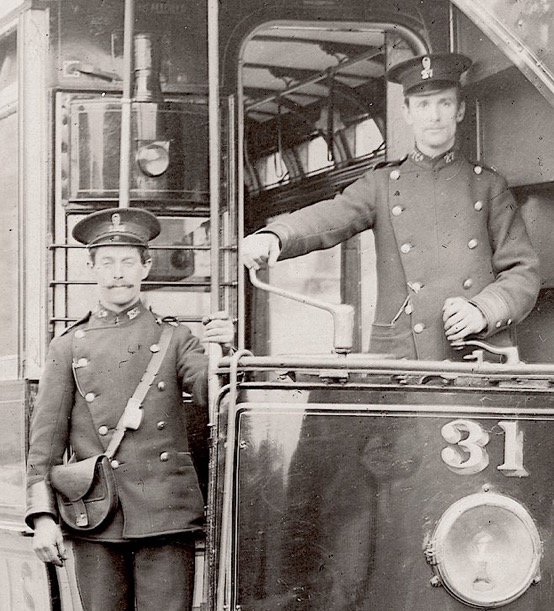
An enlargement of the above photograph, revealing the conductor to be Employee No 132, and the motorman, Employee No 27. Their collar initials are probably 'G & D T Co'. Both men are wearing lancer-style tunics rather than the double-breasted jackets seen in the earlier photograph.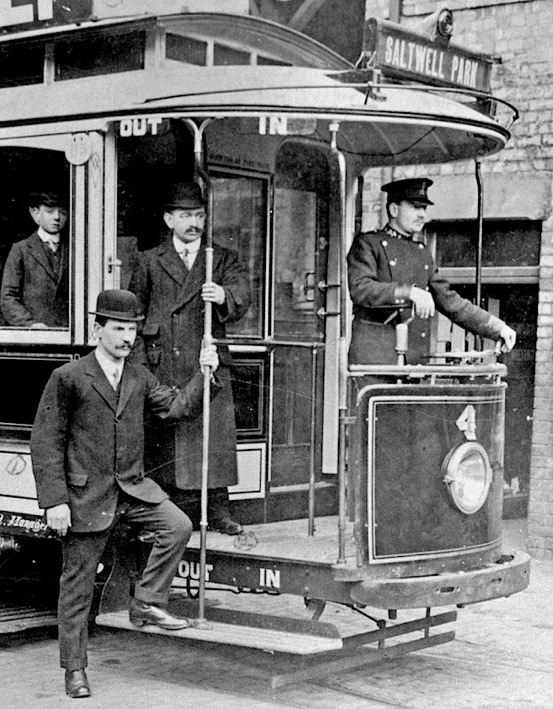
Chief Inspector Adam Armstrong (middle) and Motorman Sam Wilson aboard Tramcar No 4, newly converted for 'Pay As You Enter' operation in 1912. Image kindly supplied by Beamish Museum Limited (see link), image copyright Beamish Museum Limited.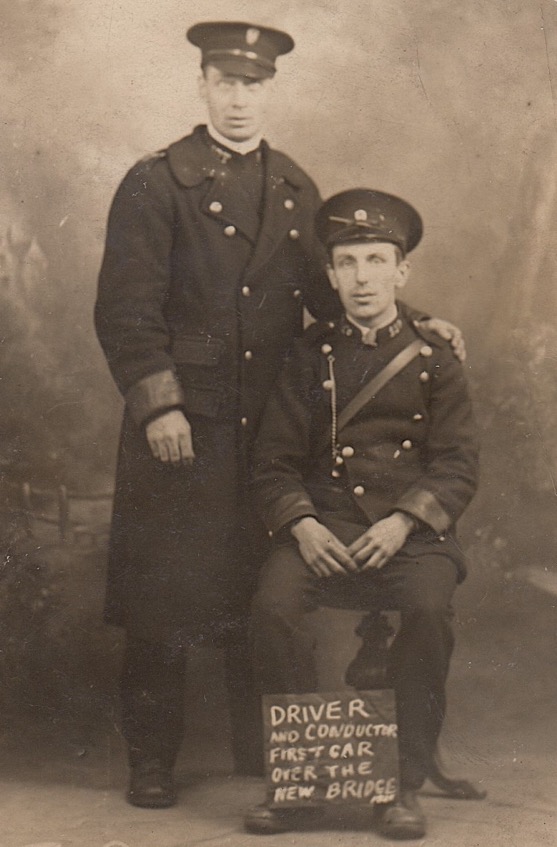
An unusual studio portrait of Motorman Bill Ward and his conductor, presumably taken at their behest to celebrate them being the first G&DTCo tramcar crew across the new High Level Tyne Bridge, which was opened in January 1923. Bill Ward was born in Walworth, but moved to the Gateshead area after the death of his wife and son shortly before the Great War, later remarrying. A family story relates that he later moved onto conducting after a member of the public deliberately jumped in front of his tram. Photo and background story courtesy of Ian Ward, Bill Ward's Great nephew.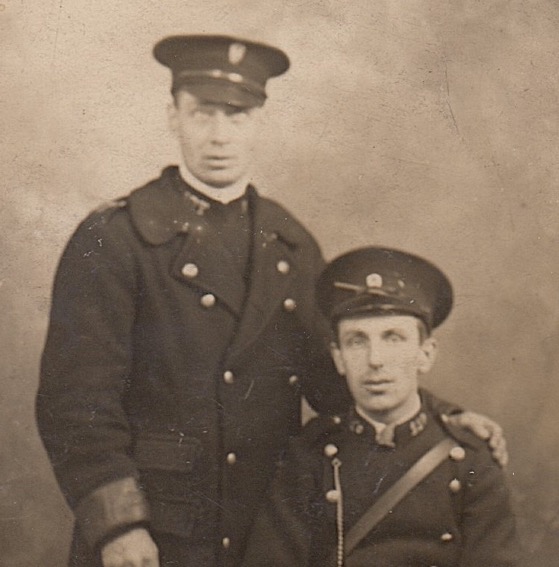
An enlargement of the above photograph showing details of the collar insignia. Bill Ward would appear to have system initials ('G D T') on his right-hand collar, whereas his colleague has company initials ending in 'Co'.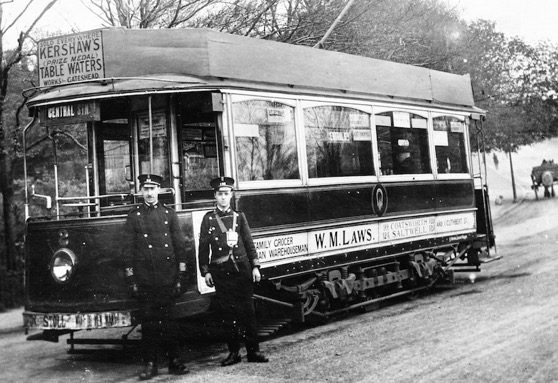
Former 'Pay As You Enter' Tramcar No 2 is captured with her crew at the terminus at Bensham. Although the photograph is undated, it is certainly no earlier than January 1923, when the High Level Bridge was opened to tram traffic, thus enabling a through service to Central Station, and no later than 1928, when the last of these cars was scrapped. Photo courtesy of the National Tramway Museum. 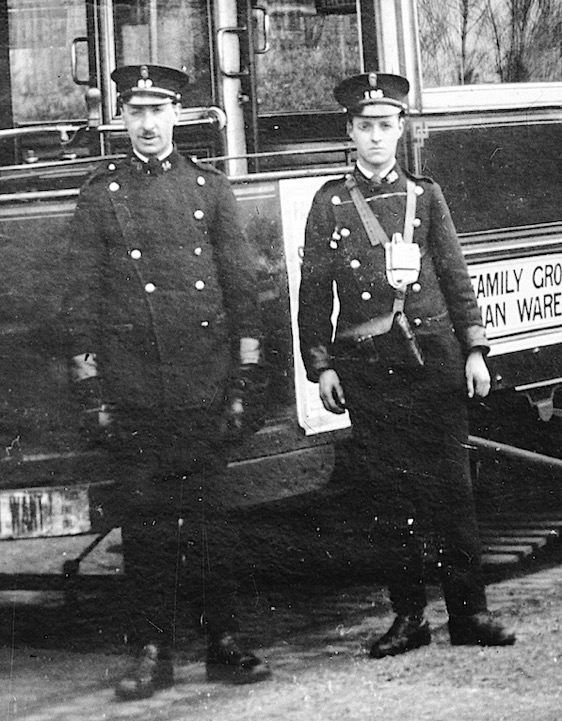
An enlargement of the above photograph showing the motorman, Employee No 14 according to his collar (not his cap though!), and the conductor, whose Employee No is unclear.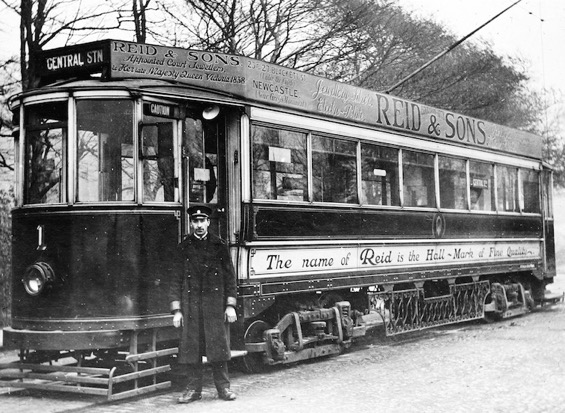
Another shot taken at Bensham, this time of Tramcar No 1 (the second car of that number) — photo undated, but probably taken in the mid 1920s, and definitely after January 1923 when services ran through to Central Station. Photo courtesy of the National Tramway Museum. 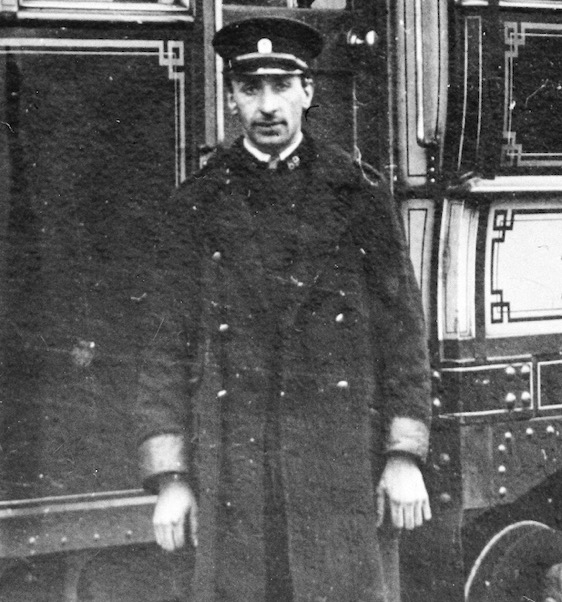
An enlargement of the above photograph showing the motorman, possibly Employee No 89. His greatcoat appears to be devoid of insignia, and his cap is without an employee number.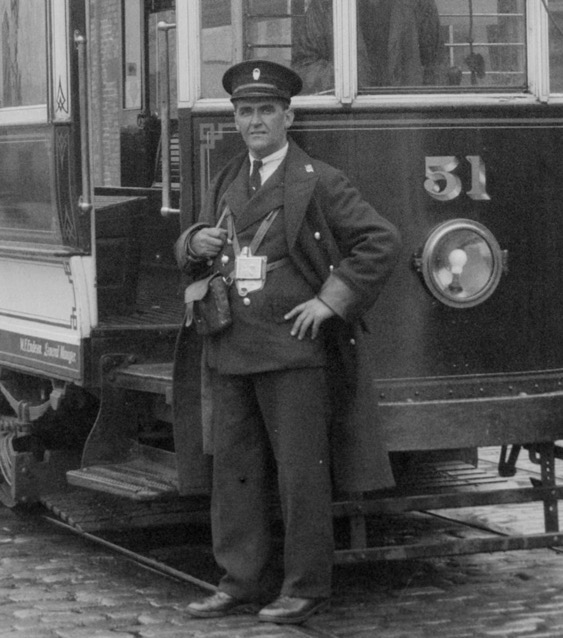
A G&DTCo conductor with Tramcar No 51 at Teams — photo undated, but probably taken in the 1930s. Photo by Dr H Nicol, courtesy of the National Tramway Museum. 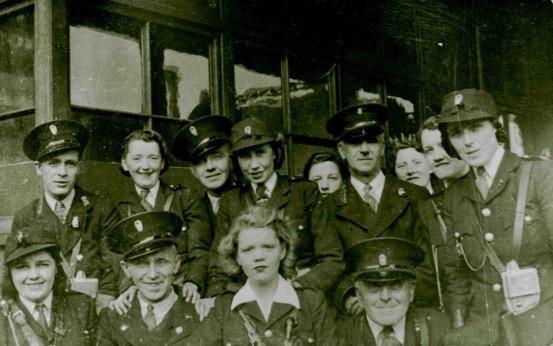
Tramway colleagues of a Mrs Weddle — photo taken circa 1940. Image kindly supplied by Beamish Museum Limited (see link), image copyright Beamish Museum Limited.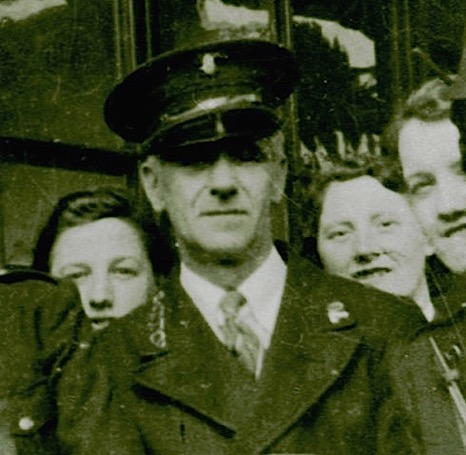
An enlargement of the above photograph showing Employee No 70. His right-hand collar carries individual system initials: 'G & D T Co'.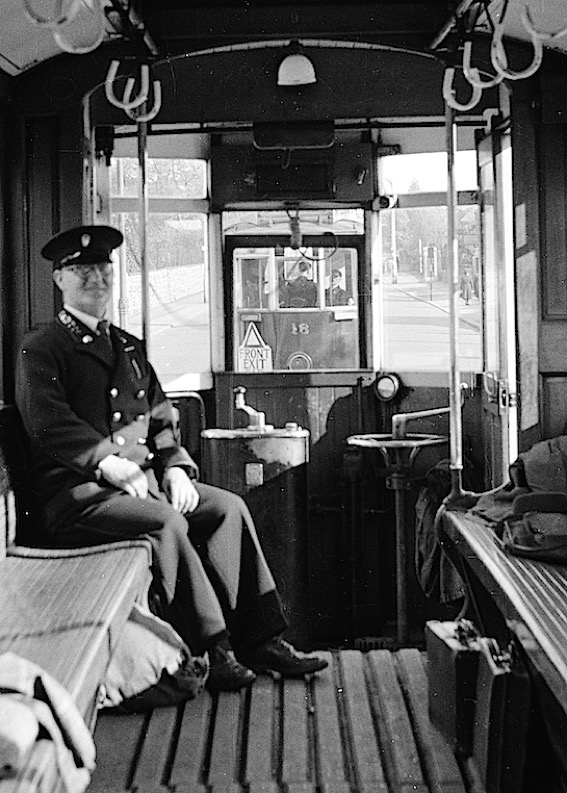
A rather unusual photograph of the interior of Tramcar No 9 with the motorman seated, and the crew of No 18 in front in animated conversation — photo undated, but very probably taken in 1950 or 1951. The motorman's smart double-breasted jacket, with its vaguely naval appearance is clear to see. Photo by M J O'Connor, courtesy of the National Tramway Museum.
Senior staff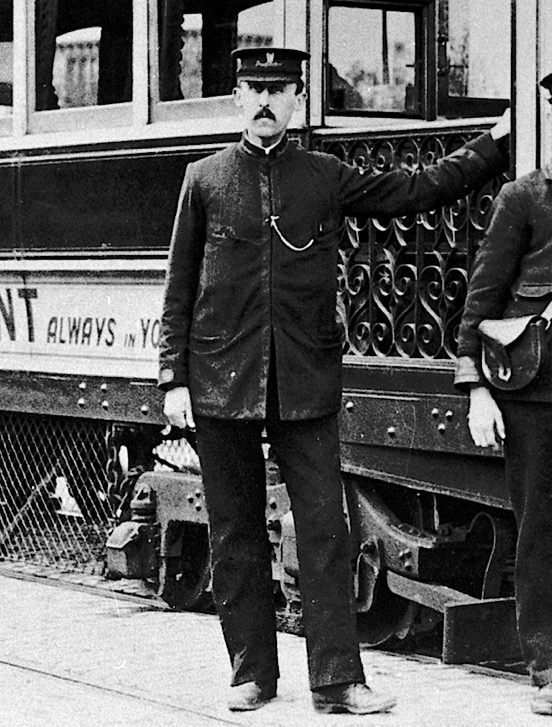
Inspector C Day — taken from the 1902 photo of Tramcar No 47 shown above. Image kindly supplied by Beamish Museum Limited (see link), image copyright Beamish Museum Limited.
Female staff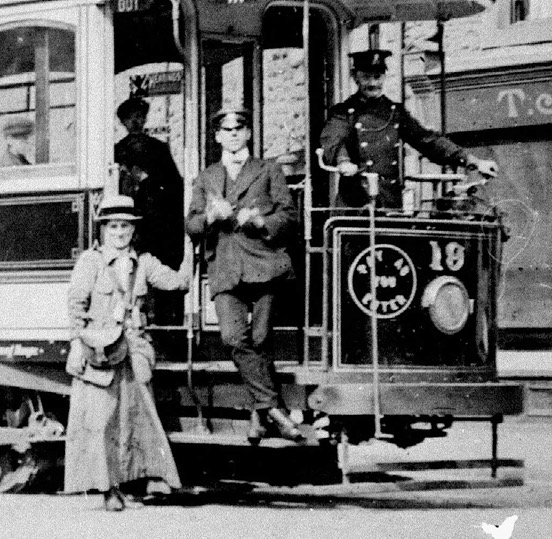
Conductress Miss Rose Vanner (holding the stanchion of Tramcar No 19) — photo undated, but very probably taken in 1915 or 1916. Miss Vanner was Gateshead’s first conductress, and later went on to become the company’s first lady inspector. In this photograph she is almost certainly wearing a makeshift uniform; clearly no investment was made in this regard until the company were absolutely sure of the change! Image kindly supplied by Beamish Museum Limited (see link), image copyright Beamish Museum Limited.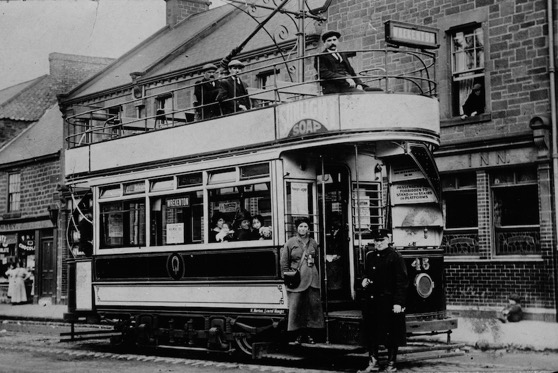
A conductress and a motorman pose with their charge, Tramcar No 45, outside the Royal Oak Inn at the Wrekenton terminus — photo undated, but probably taken in the middle years of the Great War given that No 45 was purportedly cut down to a single deck towards the end of the war. Photo courtesy of the National Tramway Museum. 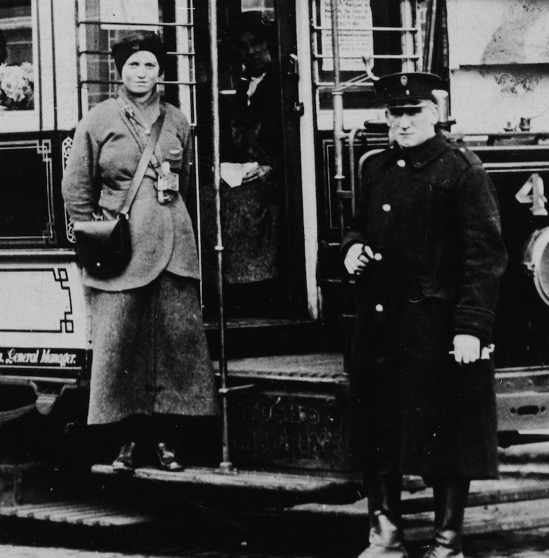
An enlargement of the above photograph showing the conductress and the motorman. The former is clearly wearing informal attire, including a close-fitting hat, suggesting a date of 1915 or 1916, i.e., before uniforms were issued.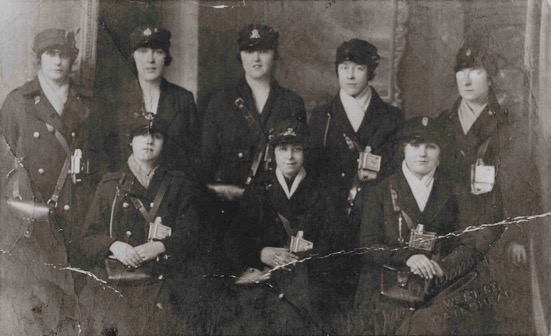
A group of Gateshead conductresses — photo undated, but almost certainly taken during the Great War. Although the two ladies on the right are wearing standard BETCo ‘Magnet & Wheel’ cap badges, the four ladies in the middle are sporting a variety of non-standard cap badges; the latter are regimental badges, a common practice amongst tramway staff during Great War, either to signify service (men) or to show solidarity with loved ones away in the armed services (so-called sweetheart badges). With thanks to Malcolm Fraser.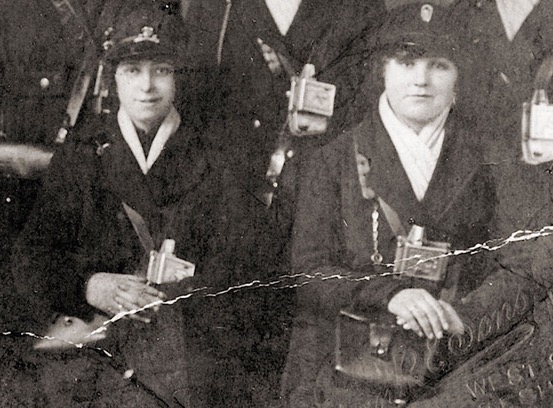
An enlargement of the above photograph clearly showing that the lady on the right is wearing a standard BETCo 'Magnet & Wheel' cap badge, whilst the lady on the left is wearing a regimental sweetheart badge. 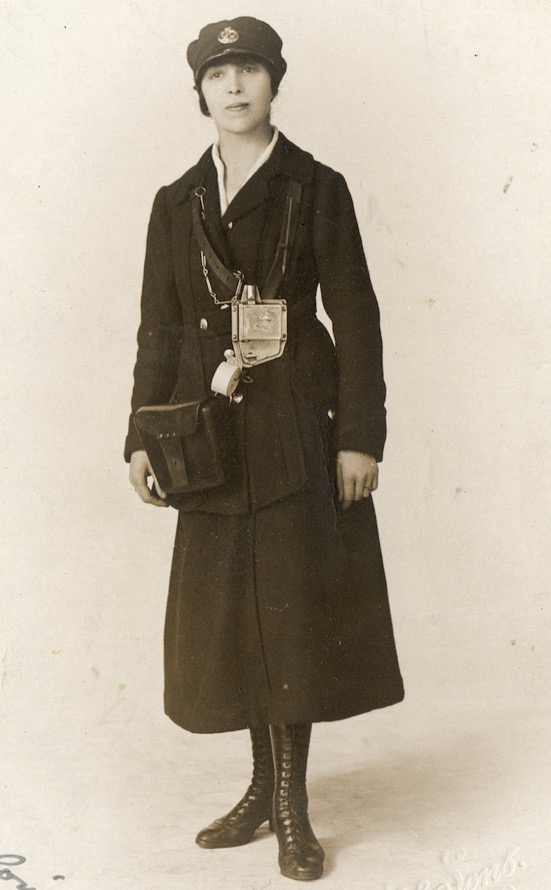
An evocative studio portrait of a Gateshead conductress — photo undated, but certainly taken during the Great War. The subject appears to be wearing a Royal Engineers cap badge, presumably as a 'sweetheart' badge (she has a ring on her wedding finger). Author's Collection.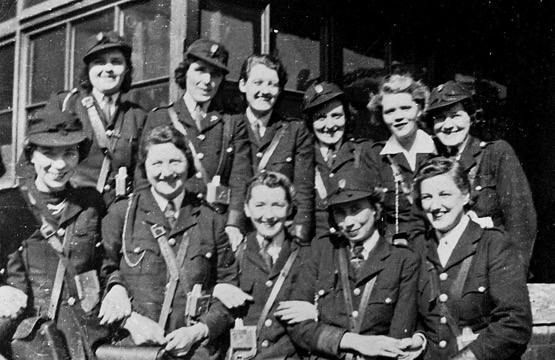
A group of Second World War conductresses, colleagues of a Mrs Weddle — photo taken circa 1940. Image kindly supplied by Beamish Museum Limited (see link), image copyright Beamish Museum Limited.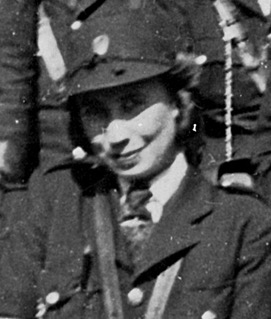
An enlargement of the above photograph showing the distinctive forage-style cap.